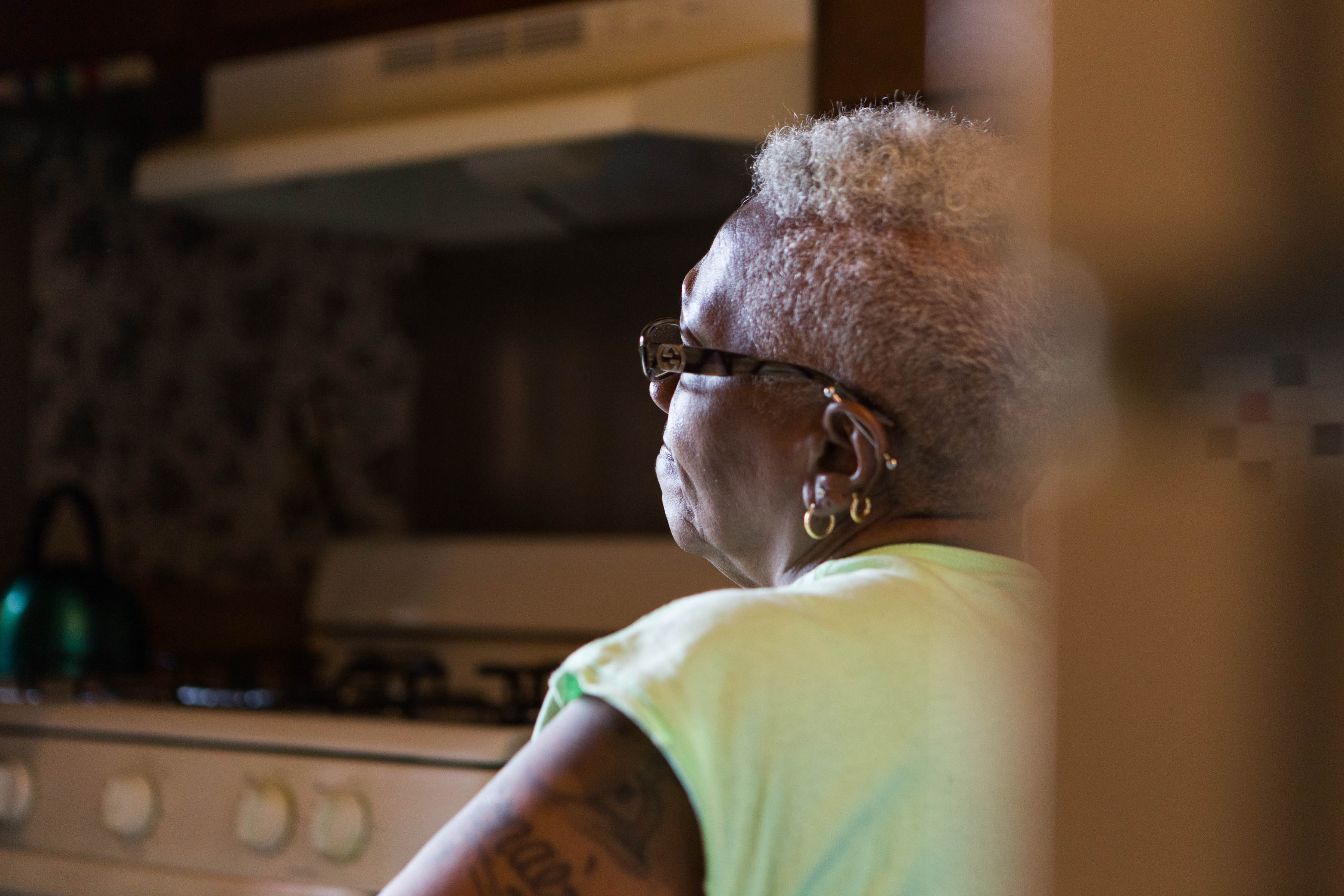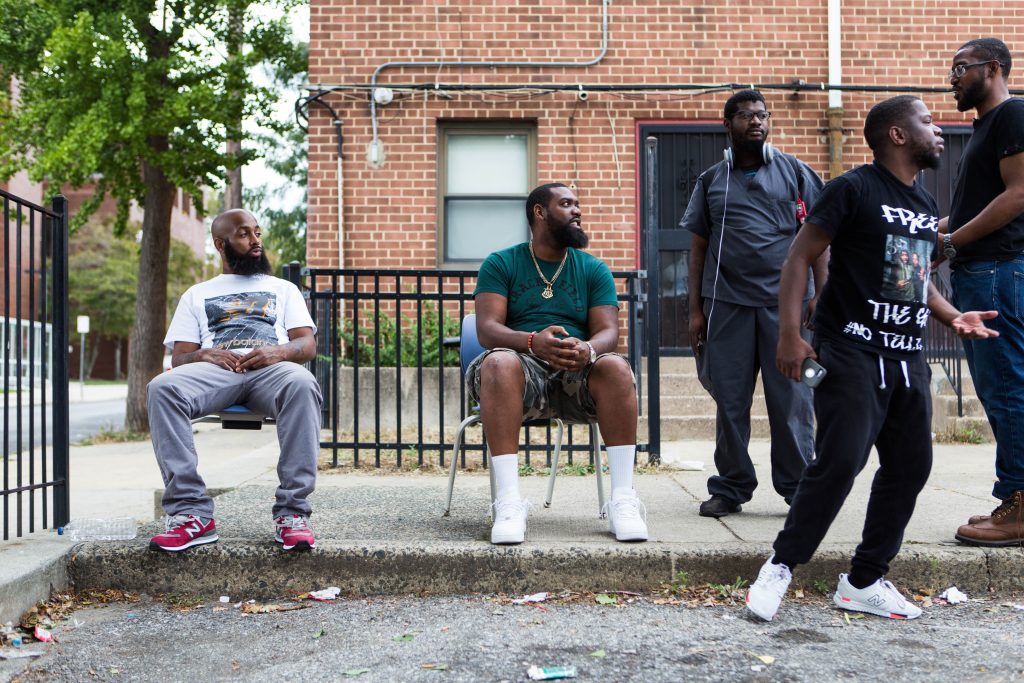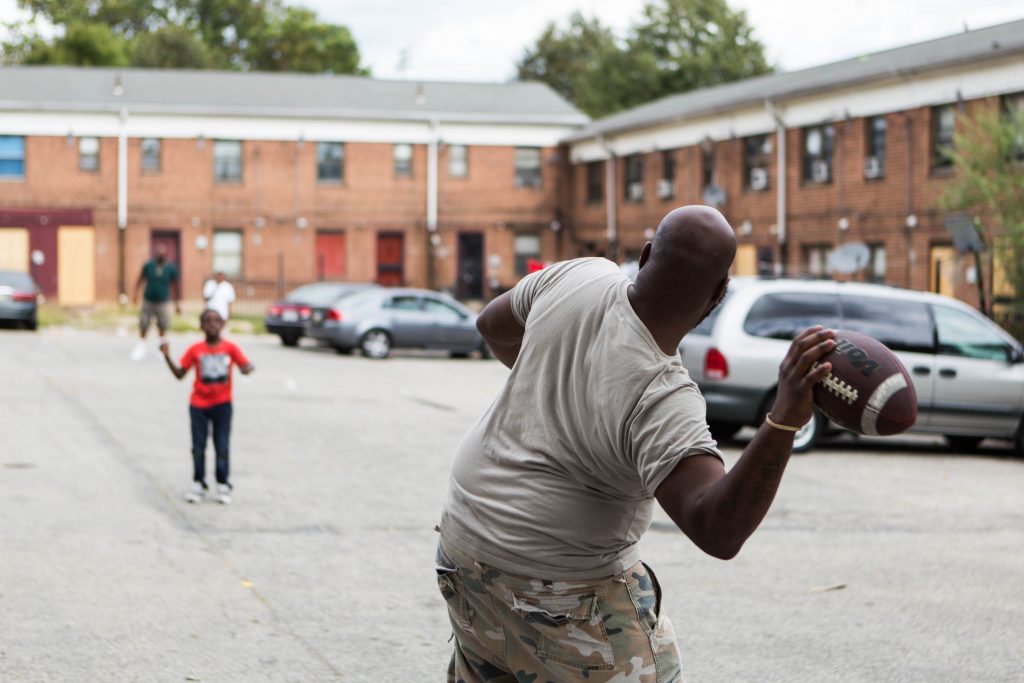Beverly Williams was quiet, looking through her open front door on an uncommonly hot October morning.
The only thing that moved was the reflection in her glasses of the two small children who lived next door, tottering around the parking lot. So much had happened in that parking lot, the 77 year old said — prom sendoffs, college and high school graduation parties, birthday parties, even a wedding reception.
She sighed.
“I don’t know,” she said. “My grandkids, they’ve been playing around here forever.”
It was silent again for a moment, then she added quietly, “They won’t be coming back no more.”
Enlarge

Williams will move out of Norris Homes, where she lived for the past 40 years, on Nov. 7.
In April 2018, the Philadelphia Housing Authority will demolish the Norris Homes housing development, located east of Main Campus on 11th Street between Berks and Diamond, to build a mixed-income development. The redevelopment is funded by the Choice Neighborhoods Initiative, a federal grant awarded to PHA in 2014. Because Norris Homes is a public housing development, residents have no choice but to leave.
Norris Homes was built in the 1950s as an affordable housing development for people who are low income, meaning tenants pay a monthly rent of about 30 percent of their total income.
There are still about 75 families living in Norris Homes, Kelvin Jeremiah, the president and CEO of PHA said. The Philadelphia Housing Authority issued a notice to residents on Oct. 2 that they had 90 days before PHA will start mandatory relocations.

The uncertainty
Ahmed Williams worries about what the move could mean for his 11-year-old brother. Williams, 21, and his family already moved most of their belongings to their new home on 19th Street near Diamond.
“My little brother, he’s 11, so he likes to go outside and play basketball,” he said. “I don’t want him to be a victim because nobody knows him, like if he goes to a park and somebody tries to fight him or something. Here he didn’t have to worry about that.”
Every resident will have to adjust in some way to moving out of Norris, some more drastically than others.
Colleen Shanahan, the founder and director of the Justice Lab at the Beasley School of Law’s Sheller Center for Social Justice, said there can be consequences to relocating residents in public housing. Adjusting to the move is one of the more difficult consequences to measure.
People with low income don’t have the economic flexibility to move multiple times, she said. While PHA assists with the direct moving costs, losing benefits like job access and the social networks people build in their communities can have an economic impact.
“If you’re a low-income person whose neighbor watched your kid in the evening while you worked your second job, and you’re moved to a different housing option, you may lose that child care and thus the ability to have a second job,” Shanahan said. “And obviously, in less tangible ways, you lose that social and emotional support.”
When this kind of social structure is disrupted, people go through “root shock,” a result of the stress people experience when they’re forced to leave their neighborhoods and lose the social networks built there. The phrase was made popular in 2004 by the book “Root Shock: How Tearing Up City Neighborhoods Hurts America, and What We Can Do About It” by Mindy Thompson Fullilove.
“I don’t think they realize that they’re uprooting people from their lives,” said Wanda Rush, 59, who has lived in Norris Homes for the past 17 years. “They’re uprooting us from our way of living, our lives. For me it’s been very stressful. … I’m starting to lose weight because of it.”
“I don’t know what my future’s going to look like,” she added. “And that’s scary for me.”
Rush is still in the process of finding a new home.

What’s coming and why
Glossary
The demolition of Norris Homes became certain in 2014, when PHA received a $30 million Choice Neighborhoods Implementation grant from HUD.
The redevelopment is expected to cost $125 million. PHA will provide $58 million, the grant guarantees $20 million and the rest will come from private funds and tax credits, Jeremiah said.
The Norris Homes development is an example of two common but controversial public housing policies: mixed-income housing and the use of Rental Assistance Demonstration when public housing is redeveloped.
The city has several initiatives to increase mixed-income developments: a 2016 ordinance gives developers “bonus” space if at least 10 percent of the development is affordable housing, and in June, Councilwoman Maria Quiñones-Sánchez introduced legislation that would require all developers to include permanent affordable housing units in future projects.
“We need to maintain a balance in the community, deconcentrate poverty,” Jeremiah said. “We don’t want to create communities that have a high number of folks who are living at or below the poverty level.”
He added that mixed-income developments would give people with low income access to more amenities like nearby stores and strive for people to pursue “social and economic mobility.”
But the effectiveness and success of mixed-income housing developments are still widely debated, Shomon Shamsuddin, a social policy and community development professor at Tufts University, wrote in The Conversation, an academic news site, in 2015.
When displaced residents return to live in the new mixed-income housing, they “tend to be happy along certain dimensions” like the quality of the neighborhood, Shamsuddin told The Temple News in February. “But there’s often a sense of social isolation and that their neighborhood community has changed and a lot of their neighbors are gone.”
Many factors affect whether Norris Homes’ residents will return to the new development. The project is part of RAD, which has a built-in right for displaced residents to move into whatever new development replaced the public housing they used to live in.
The protection is meant to be a one-for-one return rate — every person who wants to return should have a unit available for them. But any residents who choose to purchase a home are not eligible to return.
Rasheedah Phillips, a 2008 law alumna and a managing attorney at Community Legal Services of Philadelphia — which provides free civil legal services to low-income Philadelphians — said there are other factors that deter residents from coming back.
“Practically speaking, when you think about how long it takes to build housing and all of the things that happen to a family in that time period, it becomes a hardship for people,” Phillips told The Temple News in April. “Even though they have a right not to [reapply for housing,] that doesn’t mean that they can’t still be evicted and that automatically extinguishes their right to return.”
“I think really the question you want to be asking is…‘Are you taking more housing for lower-income people and replacing it with less housing for lower-income people?’” Shanahan said. “And that’s, in general, a big concern because the goal of public housing is to provide housing assistance for people who can’t afford it at market rates.”
The new development will replace each of the 147 units that will be destroyed with 297 units split between homeownership and rentals. These are then divided into affordable and market-rate units. Most of the new units will be affordable housing run by PHA. About 40 units will be available to anyone.
Jeremiah said the new development won’t be marketed toward students, but students may apply and can be selected like any other applicant in the city.
“We wanted to have a mix of units, both rental and homeownership, at various income levels,” Jeremiah added. “I think Temple’s involvement helps us shape a housing and community plan that meets the needs of everyone in the community.”
Jeremiah added that Temple helped PHA “think critically about the educational aspects” of the redevelopment.
In July 2014, the Inquirer reported that Temple, PHA, the city’s Office of Housing and Community Development and APM “worked closely with neighbors to develop the blueprint for revitalizing the neighborhood.”
In an email, Beverly Coleman, the assistant vice president for community relations and economic development, wrote that Temple participated in the application process for the Choice Neighborhoods grant. Once the grant was awarded, Temple took on the role of the lead education partner.
A tower that's not there
This exodus of residents is obvious: the boarded up homes stand out in stark contrast to the ones that are still occupied.
Residents said they knew it was eventually coming, that it had been a possibility since 2011, when PHA tore down an 11-story high-rise next to the remaining houses on 11th Street near Diamond. On that lot, PHA built 51 modern, low-rise apartments.
“When I first heard [PHA was knocking down the homes], that was years ago,” said Nomar Wilson, an 18-year-old Norris Homes resident. He’ll be moving to Strawberry Mansion after living in the development for nearly his whole life.
“I really wasn’t paying it no mind, then as I see…a lot of people moving out and stuff, ‘Wow, we’re really about to move,’” he added. “[When] they knocked [the tower] down, that’s when I started thinking, ‘We’re next if they knocked that down.’”
But the true indication of Norris Homes’ fate came in 2013 when Paseo Verde, a mixed-income development, was built by Jonathan Rose Companies. Two blocks away from Norris Homes on 9th Street and Berks, it’s operated by the nonprofit Asociación Puertorriqueños en Marcha.
Before Paseo Verde was built, the space was a parking lot. Now, the facility, which cost about $50 million to build, houses a pharmacy, a Western Union branch, an APM office and 120 rental residential units.
There are 53 units designated as affordable housing for people who earn less than 60 percent of the area’s median income — which is $83,200 in 2017, according to the United States Department of Housing and Urban Development. The rest of the units are market rate, meaning anyone who can pay the rent can live in Paseo Verde, which costs from $1,350 to $1,750 per month depending on the floorplan.
About 80 percent of the market-rate units are rented by Temple students, said Gwendolyn DuPard, the property manager for Altman Management Company at Paseo Verde. All of the affordable-housing units are filled and there’s currently a waitlist, said Rick Olmos, the director of external affairs and communications for APM.
Jonathan Rose Companies and APM will build the new housing development once Norris Homes is demolished, said PHA President and CEO Kelvin Jeremiah.

Temple & Choice Neighborhoods
Temple surrounds Norris Homes — Main Campus borders the houses to the west, Edberg-Olson Hall and Chodoff Field to the north, Temple University Regional Rail station and the university’s facilities buildings to the east.
As the lead education partner for the Choice Neighborhood Initiative, the College of Education runs after-school programs for the children at Norris Homes and leveraged $1.2 million from the initiative in resources like staffing, equipment and volunteer hours.
“[PHA is] the housing lead, but you also have educators like Temple University who has been incredible in supporting not only the housing component but also the after-school program,” Jeremiah said.


LEFT: A group of men sit in the parking lot on Norris Street between Marvine and 11th streets. RIGHT: Webster, 27, throws a football in the parking lot on Norris Street between Marvine and 11th streets. He grew up in Norris Homes and has lived with his aunt and grandmother for the past 18 years. | SYDNEY SCHAEFER / THE TEMPLE NEWS
James Earl Davis, who holds the Bernard C. Watson endowed chair in urban education, oversees Temple’s involvement in the Choice Neighborhoods Initiative.
“We have families and children that are important and we can’t lose sight,” Davis said.
Through the Choice Neighborhoods Initiative, Temple has also generated more than $1 million in donations and grants for the existing after-school programs and summer camps. Davis said he hadn’t even set a goal to raise any money.
Funding for the Choice Neighborhoods Initiative and grants and donations helped fund multiple positions for residents, like a program administrator.

A quiet remembrance, then goodbye
Receding into the grassy hill where the Regional Rail tracks cross over Norris Street are seven brick walls, painted to look like Norris Homes across the street. The houses will soon be gone, but the paintings will remain.
The mural, “The Norris Homes Historical Marker,” was completed in 2015 as part of the Mural Arts Philadelphia program. Jennie Shanker, the mural’s artist and an adjunct professor in the Tyler School of Art, led after-school programs and created the Norris Yearbook, a photographic documentation of the families in the development.
She also painted doors and windows on the boards that covered the homes residents have already left. At first glance, the houses appear to have a normal door and windows.
“Initially people were like, ‘They’re just going to rip that down. Why are you wasting your time?’” she told The Temple News in December 2016. “Then people started coming up and saying, ‘You know, you’re doing that wrong. We don’t have shades like that. That’s so-and-so’s house. Are you going to paint them in the window?’”
Residents like Ahmed Williams will still remember Norris Homes long after the houses are gone.
“The [new] house is good and all that, but memories,” Ahmed Williams said. “I grew up in this house. My little brother, he was born in this house. I’ve been living here since I was 2.”
“It’s a heartache,” he added. “This is the last of my days sitting here. And when I come next time…the whole memory of everything is going to be different.”
Enlarge

Even though Beverly Williams’ kitchen is still full of trinkets and photos of her grandchildren, she’s getting ready for when she moves out next month. Earlier this month, her neighbor, Frances Dixon, 43, walked in with her family to tell Beverly Williams they were off to a hair appointment. One of the toddlers who had been playing in the parking lot asked if Beverly Williams had a popsicle.
“[Norris Homes] was real nice,” Beverly Williams said. “It’s a place that I would like to always live, instead of out in other places.”
She was looked around her kitchen like she was taking it in for the last time.
“I’d rather be here than anywhere else.”
EDITOR’S NOTE: A previous version of this story misstated the year Rasheedah Phillips attained her law degree. She graduated from the Beasley School of Law in 2008.
Julie Christie can be reached at julie.christie@temple.edu or on Twitter @ChristieJules.
Photos by Sydney Schaefer.
Illustrations by Courtney Redmon.
Videos by Abbie Lee and Ian Schobel.
Produced and designed by Julie Christie and Greta Anderson.
First published Oct. 17, 2017.



